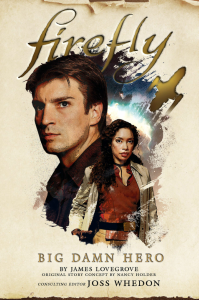A line of “Firefly” novels was advertised in the back of the “Serenity” novelization in 2005, but it wasn’t until 13 years later that we saw the first entry in the series. Written by James Lovegrove based on a story idea by “Buffy” tie-in veteran Nancy Holder, “Big Damn Hero” (November 2018) combines a couple of concepts — sometimes effectively, sometimes awkwardly.
The Serenity crew (and Mal himself) must figure out who kidnapped Mal and why. Also, violent anti-Browncoat sentiment has sprung up on Persephone.
Slow unveiling
“Big Damn Hero” is overwritten, but the sheer pleasure of reading a “Firefly” novel overcomes the leisurely unveiling of the mystery for me. I expect other readers might find the slow burn frustrating, especially since the payoff isn’t surprising. But Lovegrove gets all the characters more or less correct.

“Big Damn Hero” (2018)
Authors: James Lovegrove and Nancy Holder
Series: “Firefly” No. 1
Genre: Science fiction
Setting: Immediately after “The Message” (episode 12)
Sometimes the flirtation between Wash and Zoe is a bit much, but the author successfully reminds us where everyone stands at this point in the storyline, right after the events of “The Message” (1.12). Kaylee and Simon are making eyes at each other, and River unleashes more of her as-yet-unexplained mathematics-based fighting skills, so memorably introduced in “War Stories” (1.10).
Lovegrove adds intrigue to Book, continuing from the surprise in “Safe” (1.5) wherein we learn Book has status within the Alliance. (His full story would be revealed in the 2010 comic “The Shepherd’s Tale.”) Book chats with an old Alliance military contact to get leads on Mal’s disappearance.
Thematically, “Big Damn Hero” is like “War Stories” in that it’s about teamwork in Mal’s absence – although Mal’s leadership lessons linger for Zoe, the acting captain. But the best reason to read the book is for the backstory of Mal’s teenage years on his home planet of Shadow.
The bittersweet love story between Mal and Jinny reminds me of Han Solo’s first love in the excellent “Star Wars Legends” “Han Solo Trilogy” by the late A.C. Crispin. There, we gain appreciation for Han’s loner attitude, imagining he’s thinking on some level about Bria Tharen whenever a new woman of significance enters his life.
Loner by preference
The same goes for Mal, who obviously has the looks and swagger to be a ladies’ man, but prefers being a loner. When he develops feelings for Inara, he is hesitant and awkward. That’s not just something that makes for great TV; the behavior is rooted in Mal’s experiences.
It’s slightly disappointing that Toby’s reason for wanting to execute Mal after a kangaroo-court trial before disgruntled Browncoats is their old romantic rivalry for Jinny. Still, the flashbacks to their youthful exploits are “Big Damn Hero’s” highlight, as Mal, Toby, Jinny and Jaime make up a Four Amigos in their Old West backlot type of town. We learn about how and why Mal and his friends sign up for the Independent cause, and we get glimpses into some battles.
More head-scratching than Toby’s betrayal of Mal is that this sizable group of Browncoats believes Toby’s contention that Mal was a traitor to their cause. Granted, it’s not impossible; we as readers know of Mal’s and Zoe’s bravery and strong leadership during the war, but that was only six years earlier on the timeline. Historians have not sorted things out yet, and besides, the victors get to write the history books.
Lovegrove presents the interesting notion that people on the losing side of a war might turn on their own people, rather than the victors, as a safer way to vent their frustrations. He mentions an underground anti-Browncoat movement on Persephone (a Rim planet conquered by the Alliance), but doesn’t delve into it much.
Then again, the parallel between Alliance Day and the Fourth of July is well taken, and the author does nicely illustrate the haves-versus-have-nots nature of Persephone’s spaceport city. But it sure is a shame that Browncoats become the targets of the lower class’s frustrations.
Space geography
I think the attempted hanging of Mal in a cave on the moon of Hades is an attempt to blend Western tropes with science fiction. But it got me thinking more about the space geography in the “Firefly” ’Verse.
I’ll have to check out my reference books to learn more, but Lovegrove presents the notion that Hades successfully had atmosphere added to it, but that was the extent of humanity’s impact, since the moon isn’t rich enough in minerals to be worth the mining expense.
It seems that terraforming (making a globe more like Earth, for the livability of humans) is a relatively easy endeavor for the science of the time, perhaps with the creation of atmosphere being the first and easiest step. This would explain why there are so many habitable spheres accessible for a ’Verse in which lightspeed isn’t possible (although very fast sublight speeds are a given).
“Big Damn Hero” is not on the same level as the latter Dark Horse “Serenity” comics, which are farther along the timeline and are probably more directly overseen by Joss Whedon. But I appreciate that Lovegrove’s task is trickier, as he’s essentially writing episode 1.13.5 within an established continuity, and that comics, TV and movies can skim over logistical details in ways that novels can’t.
Considering that there’s no budget limit for a book, it’s disappointing that the locations are run-of-the-mill — although Persephone, Shadow and Hades are all well portrayed for what they are. But it’s nice to get Mal’s backstory, and I’m looking forward to reading Lovegrove’s next entry, 2019’s “The Magnificent Nine.”


